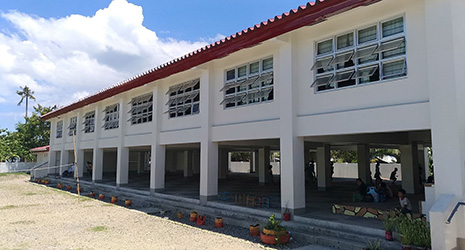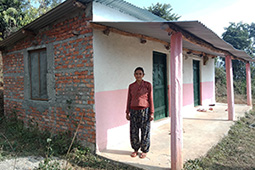INDEX
- English
- 日本語

An elementary school rebuilt with high floors using a grant from the Programme for Rehabilitation and Recovery from Typhoon Yolanda - English
- 日本語

Nepalese construction operatives undergo practical training from JICA in earthquake-resistant housing

An earthquake-resistant house built with JICA support in Nepal
June 2020
Building the World Back Better

Japan has advanced its strong nation-building efforts against disasters by utilizing the lessons learned from earthquakes, typhoons and other natural disasters. Currently, Japan is working to contribute to the world by sending out the knowledge and experience gained from its nation-building under the concept “Build Back Better.”

The UN World Conference on Disaster Risk Reduction has been held in Japan three times, discussing international strategies for disaster risk reduction. The third Conference in 2015 was held in the city of Sendai, Miyagi Prefecture, an area affected by the Great East Japan Earthquake of 2011, and at this Conference, the Sendai Framework for Disaster Risk Reduction 2015–2030 was adopted. During the Conference, four priorities for action were established: (1) Understanding disaster risk, (2) Strengthening disaster risk governance to manage disaster risk, (3) Investing in disaster risk reduction for resilience, and (4) Enhancing disaster preparedness for effective response and to “Build Back Better” in recovery, rehabilitation and reconstruction.
Build Back Better is the concept of rebuilding an affected area to a state that is stronger against disasters than it was before the disaster, rather than just restoring the area to its pre-disaster state. In Japan, based on lessons learned from the many natural disasters that occur here, various measures have been implemented. These measures, which include the establishment of laws related to disaster risk reduction and improvements of the infrastructure of disaster risk reduction, have supported the preservation of a safe society and stable economic growth.
Utilizing these experiences, Japan is currently putting effort into international cooperation for disaster risk reduction.
“In developing countries, sometimes a town in disaster-affected areas is rebuilt as it was before the disaster. In these cases, the areas are often damaged in similar ways as before when another natural disaster occurs,” says Matsumoto Hideaki, from the Global Environment Department at the Japan International Cooperation Agency (JICA), an incorporated administrative agency under the jurisdiction of the Ministry of Foreign Affairs of Japan. “To prevent damages from natural disasters from reoccurring, it is necessary to promote the strengthening against natural disasters for the entire country through the establishment of infrastructure and legal systems that are based on the lessons learned from natural disasters.”
JICA is carrying out various projects in developing countries, aiming to Build Back Better.
Below are some support projects that were carried out in two different countries.
Republic of the Philippines
The Project on Rehabilitation and Recovery from Typhoon Yolanda began in February 2014 in areas affected by Typhoon Yolanda, which caused great damage to the Philippines in November 2013. Through this Technical Cooperation project, JICA experts supported the creation of hazard maps for storm surges and flooding, and held workshops discussing local evacuation plans in which local government employees and residents studied the hazard maps. Subsequently, the Philippine government built a tide embankment using their own budget. Additionally, JICA provided grant aid through the Programme for Rehabilitation and Recovery from Typhoon Yolanda for the rebuilding of elementary schools and hospitals, as well as for the procurement of necessary materials and equipment for the restoration of electricity, airports and meteorological radars. Elementary schools were rebuilt with high floors to reduce damage from water flow in powerful storm surges, and at the same time, wide corridors were equipped so that the schools could also be used as evacuation shelters during disasters.
Federal Democratic Republic of Nepal

In Nepal, support was offered for the rebuilding of housing that was destroyed through earthquakes in regions of the country affected by the large earthquake that occurred in April of 2015. Approximately half a million houses were destroyed in this earthquake, and many residents lost their lives. Most of the destroyed houses had been made through a traditional technique of filling in the gaps between piled up stones or bricks with mud. Through the Project on Rehabilitation and Recovery from Nepal Earthquake, which began as soon as July of the same year, JICA offered support in drafting the Minimum Requirements for rebuilt housing and held training related to rebuilding houses for construction operatives and residents. Additionally, through the Housing Emergency Recovery Project, JICA provided funds through an ODA Loan to the Nepalese government’s Housing Reconstruction Program supporting owners of earthquake-damaged homes for rebuilding housing that met the Minimum Requirements of earthquake resistance. When it came to rebuilding, local construction operatives who had undergone JICA training visited towns, offering advice to residents. As of April of 2020, a completion rate of roughly 87% for earthquake-resistant housing has been achieved for the roughly 83,000 households eligible for assistance in the two districts in which JICA offers support.
“Through a variety of support, I feel that an awareness of the importance of investments in disaster risk reduction before disasters occur is steadily spreading among concerned parties in various countries,” says Matsumoto. “We will further our efforts providing support that protects life and property.”
Build Back Better will lead to a safer world, where tragedy from disaster is much less likely to reoccur.

